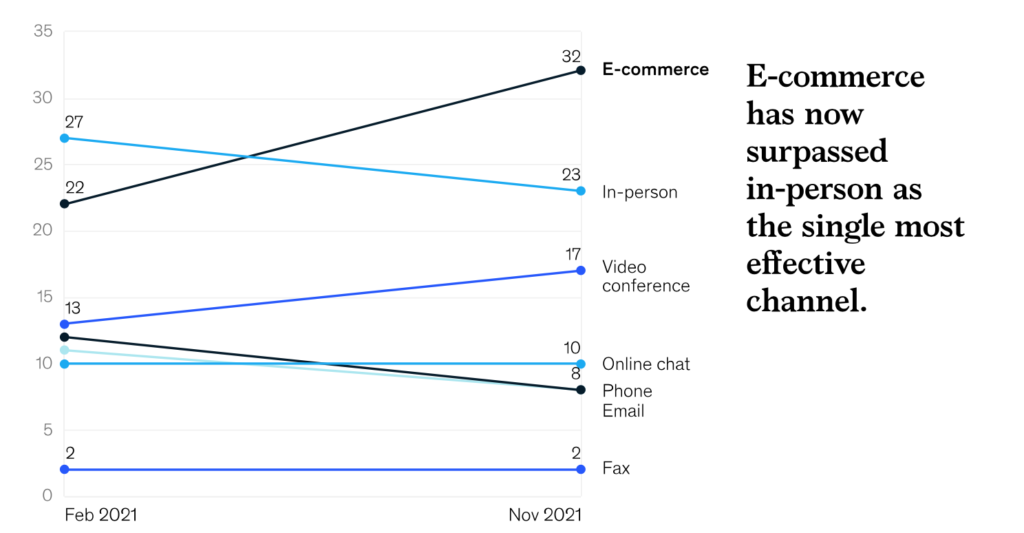2023 is a year when B2B online selling became the default. Today, businesses are investing in transforming their B2B eCommerce to keep up with their customers’ expectations.
With the rise of smart speakers and virtual assistants, voice commerce, and live-stream shopping, are expected to become more common in 2024. Businesses are optimizing their websites and product listings to accommodate these trends to provide exceptional shopping experiences for their customers.
McKinsey & Company reported that B2B eCommerce has taken the lead as the most effective sales channel. It is rated first by 35 % of respondents, ahead of in-person sales 26 %, video conferences 12 %, email 10 %, and telephone 8 %. Companies winning market share have not only digital self-serve channels such as their own websites but also broader eCommerce offerings.
In addition, McKinsey & Company stated that about 65% of B2B companies across different industries fully transact online. B2B businesses are more likely to offer eCommerce channels than in-person selling. Ecommerce became the most effective sales channel for a plurality of B2B. Also, the same study from Mckinsey & Company shows that about 18% of B2Bs’ revenue is coming directly from eCommerce, higher than phone, email, and video conferencing.

according to McKinsey & Company reports
Top B2B Ecommerce Growing Trends
This blog summarizes today’s top B2B eCommerce growing trends that every business needs to know.
For many B2B businesses, converting new online buyers into permanent customers is still challenging. Thus, here are some of the top B2B eCommerce trends to follow for retaining and keeping your customers happy.
1. Digital Transformation and Implementing an eCommerce Platform
Not all commerce platforms offer the same functionalities. For example: with a modern SaaS eCommerce solution, like BigCommerce, you can get all the benefits that come with SaaS. You will leverage robust security, speed to innovation, and lower total cost of ownership, as well as features that support the complexities of B2B. Another key element is your ability to easily integrate with your other business systems. On the other hand, you can also look for a fully integrated B2B solution that is powered by a headless commerce platform. With a headless platform, you do not have to reinvent the wheel, unlike a monolithic system.
B2B Connect is a pre-composed headless solution for B2B, B2C, and D2C Commerce. It is a business-ready solution providing a quick start and rapidly launching simple-to-complex eCommerce experiences with advanced quoting workflows, account management, subscriptions, complex catalog support, role-based access, and more.

B2B Connect solution is pre-integrated to major headless platforms such as fabric, BigCommerce, and elastic path.
2. Personalization and Customization Shopping Experience
Many B2B business owners choose to go with headless commerce as it allows them to create a personalized and customized shopping experience for their customers much more quickly than monolithic legacy systems. In fact, it is a lot more flexible and cost-effective to customize and tailor user experiences with headless commerce, unlike legacy platforms.
Many confuse customization vs personalization for the user experience thinking they are the same thing. While they do differ, they also share a similar goal in creating a unique shopping experience for the customer while still utilizing independent strategies and tactics to achieve the desired outcome.
Research shows that 50% of B2B buyers identified improved personalization as a key feature when searching for online suppliers with whom to build relationships, with consumers spending 48% more when their experience is personalized.
To personalize your customer’s shopping experience, DigiCommerce can guide you to make these changes effectively. They can set up your commerce site in a way that will help identify the customers to deliver tailored content specific to their customers based on previous purchasing history. Likewise, your sales and marketing teams can personalize special offers and display recommended options for your customers based on their previous purchasing data.
However, the user is the one who sets their own customization preferences. Your customer can customize the app or software they use for their purchases and set their preferences. That is to say, your customers can set their preferences that meet their specific needs—for example, choosing their own selections for certain products or services of interest, and setting preferences for how to display certain information. They can also set their preferences for the visual design aspects of an interface such as colors or modifying the layout.

3. Investing in Product Discovery & Order Management Fulfillment
Some of the main challenges for B2B buyers during their online shopping journey are finding the products they want and executing their orders swiftly. It is not an understatement to say “product discovery and order management” can either make or break a business. If your customers can not find what they want on your site, they will turn to your competitors. Likewise, if they find difficulty executing their purchase orders, they will search for other faster and more efficient alternatives.
Your customers should be able to easily find what they are looking for from your commerce storefront, mobile app, social sales channels, or even marketplaces. Otherwise, they will turn to your competitors. It is key to find the right and most up-to-date information for the products or services they are searching for.
On the other hand, investing in integrating an order management system into your commerce site is as crucial for your business. Today more than ever, B2B businesses need to guarantee fast and efficient fulfillment processes for their customers. An order management system is increasingly needed to streamline an order process in the most cost-effective and automated way possible to increase revenue. To name a few of the advantages:
- Automation of the entire process and Facilitates Inventory management: tracks stock availability; communicates with suppliers and calculates shipping costs.
- Eliminating human error which in turn saves time and reduces costs in the long run.
- Multi-channel and Omnichannel sales: It facilitates selling across all eCommerce platforms and different sales channels as well as on social media.
- Cross-Border Selling: It manages orders within different countries and different currency types.
- Faster Delivery and Splitting orders to different locations
- Scalability: Grows with your business needs.

4. Leveraging Selling on Third-Party Marketplaces
When many purchasers start their search for their desired products or services, they will go to marketplaces. In fact, one of the best advantages of third-party marketplaces is their ability to attract new customers. In addition, B2B businesses can leverage selling through marketplaces to reach global customers. Examples of marketplaces are Amazon, Walmart, eBay, Easy, Alibaba, and Google Express. In fact, there are now more than 150 online marketplaces you could potentially leverage to maximize your customer reach. Research shows that customers nowadays start their product search, and often end with their purchases on marketplaces. If your products are not showing up in these search marketplaces. Then there is a high chance your customers will not be visiting your online store. Definitely, if you want to expand your commerce business. Then levering online marketplaces is a must and could be the best platform for selling your products.

5. Exploring Social Media Selling
It is a misconception to think that social media is a channel for only B2C businesses. In fact, B2B buyers are already using social media for their purchases. According to Gartner, about 46% of B2B buyers use social media to learn more about available solutions. 40% use it to compare answers, and 35% use it for need-to-know information before they complete a purchase. Furthermore, interestingly, Gartner also found that 54% of B2Bs have used social commerce to set up an online store. Today Social media channels are for any marketer given the flexibility it offers. Many businesses underscore the importance of a B2B social media strategy in buyer journeys.
As John C. Maxwell said, “Change is inevitable – Growth is optional.” While B2B business owners were debating whether they needed to embark on the digital transformation journey. Today, there is no time to waste. B2B entrepreneurs’ main focus should be on investing in these top eCommerce growing trends. Their priority should be implementing their strategies for “how to optimize their customers’ online shopping experience” to keep up with their ever-evolving demands and expectations. And be ahead of the game!
We at DigiCommerce can help you align your business goals to take full advantage of the technology and drive measurable results for your business.
With a footprint that spans from North America to Asia. Our role is to advise you with business solutions that best fit your business needs. Get in touch today with our experts to learn more about the top B2B eCommerce business trends; and how to optimize your eCommerce business and enhance your customers’ user experiences.

